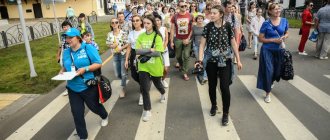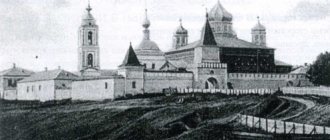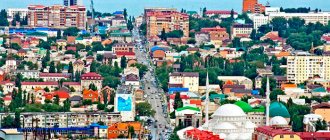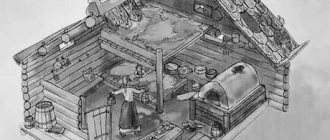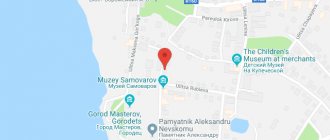Gorodets is one of the small towns in Russia. Over the centuries of its history, it has experienced periods of prosperity and decline, glory and oblivion. Gorodets was a city of ambitious princes and talented craftsmen, a city of stern Old Believers and enterprising merchants.
Gorodets stands on the high bank of the Volga, 53 km up the river from Nizhny Novgorod. Like many cities of Ancient Rus', the date of its foundation is unknown. It first appeared on the pages of chronicles in 1172 as an already existing fortified city.
The choice of the Gorodets construction site was determined by its purpose - control and protection of salt production. Salt was highly valued and was often the same equivalent to money as gold, silver and furs. The military river ships of the town residents, constantly stationed in the bays under the city, blocked the Bulgars’ path along the Volga deep into the Russian lands, and the city itself became a gathering place for Russian squads and their preparation for campaigns in the Ponizov region, a place for diplomatic meetings and negotiations of the great Vladimir-Suzdal princes with those who held power peoples between the Oka and Volga rivers.
Gorodets Fortress
Three lines of fortifications of the 12th-13th centuries, which initially formed the city’s defense system, remain a unique ancient monument in Gorodets. Such fortifications are rare not only for the Nizhny Novgorod Volga region, but also for the country as a whole. The construction of the Gorodets fortress began with the construction of a ditch and ramparts of the Prince's Mountain (Detinets) - a flat, elevated plateau of the left, here high, bank of the Volga, bounded on both sides by deep ravines. Ramparts and ditches (about 550 meters) encircled Prince Mountain in an arc, breaking off at the ends with screes towards the Volga. Detinets occupied only 3.5 hectares. The width of the base of the rampart was 22 meters, and the width of the ditch was 18 meters, with a total height of the rampart embankment of up to 7 meters. The fortress moat of Prince Mountain was 5.15 meters deep with a sharply sharpened piece at the bottom. The Gorodets ramparts were second in height only to those of Kyiv. Before the founding of Nizhny Novgorod in 1221, Gorodets was the main stronghold of the Russian princes in the Middle Volga region. Since its inception, Gorodets-Radilov has never allowed Bulgar military ships to pass along the Volga deep into Russian lands.
Gorodets Street Photo: account.travel
In February 1238, Gorodets shared the tragic fate of Vladimir Rus': it was devastated by Batu’s troops. With this event begins the history of one of the shrines of Russia - the Kostroma miraculous icon of the Feodorovskaya Mother of God. According to legend, this icon was kept in Gorodets, and after it was burned by enemies it was miraculously transported to Kostroma, where it was found again. The town residents already returned the copy of this revered icon to their city, to the monastery, later named Feodorovsky.
The history of Gorodets is connected with the name of the great Russian commander Alexander Yaroslavovich Nevsky. In the autumn of 1263, returning from the Horde to Rus', the prince fell ill and here, in Gorodets, died on November 14 (old style).
At the end of the 13th century, Gorodets became the center of an appanage principality headed by one of the sons of Alexander Nevsky, Prince Andrei. During the years of his reign, Gorodets became as prominent a political center as Tver and Moscow. Andrei Gorodetsky entered the history of Rus' as the initiator of long and brutal strife. In the winter of 1293-1294, he brought a large Horde army (“Dudenev’s army”) to Rus', with the help of which he seized the grand-ducal throne from his elder brother. Andrei Alexandrovich reigned in Vladimir for ten years. He died on July 27, 1304 and was buried in Gorodets in the Church of the Archangel Michael. With the death of Prince Andrei, the city quickly lost its former political significance.
History of the founding of the city
Gorodets is the most ancient city in Nizhny Novgorod, almost the same age as Moscow. In 1152, Yuri Dolgoruky, having crossed the ancient river Ra at the place where Unzha flows into it, reached the heights where he found the village of Maly Kitezh. There was a small monastery here where the first Russian settlers, monks, lived. Yuri founded a city here and gave it the name Gorodets - Radilov, which means Gorodets on the Volga or Volzhsky Gorodok. There is another version of the explanation for the name. In 1147, Radil was the ambassador of Prince Izyaslav Mstislavovich to the people of Kiev and spoke at a meeting at St. Sophia. Later, he apparently found himself surrounded by Yuri Dolgoruky and, when he left for the Rostov-Suzdal land, he became his confidant during the founding of Gorodets, leaving his name as a clarifying name for the ancient city for centuries.
The choice of the Gorodets construction site was determined by its purpose - control and protection of salt production. Salt was highly valued and was often the same monetary equivalent as gold, silver, and furs. The military river ships of the town residents, constantly stationed in the bays under the city, forever blocked the Bulgars’ path along the Volga deep into the Russian lands, and the city itself became a gathering place for Russian squads and their preparation for campaigns in the Ponizov region, a place of diplomatic meetings and negotiations, the great Vladimir-Suzdal princes with the peoples who held power in the area between the Oka and Volga rivers.
The initial place of origin of ancient Gorodets was the area of the Prince's Mountain. The fortress ramparts of Gorodets around Detinets and Posad had the shape of two concentric arcs, the ends of which faced the Volga. The shaft was made of pure continental sand, construction lasted 30 years, the earth had to be carried in buckets and even in hems and hats. The eastern slope of the shaft had a steepness of up to 40%. The length of the shaft was about 2100 meters. The Posad shaft had three passages with towers and gates.
Already in 1155, Gorodets became the center of the Rostov-Suzdal principality, acquiring the significance of a transshipment point on trade routes from Vladimir, Suzdal, and Rostov the Great.
At the behest of Prince Yuri Vladimirovich, the construction of the St. Michael the Archangel Cathedral, as well as the famous Fedorov Monastery, began.
Prince Yuri Dolgoruky did not rule Gorodets for long. He handed over the management of the city to his son Vasily, who was the first appanage prince of Gorodets.
Formation of Gorodets
A new stage in the history of the city began in the middle of the 14th century. In 1341, the Grand Duchy of Nizhny Novgorod arose, one of whose appanages was Gorodets. Boris Konstantinovich reigned here - an ambitious and energetic politician, an irreconcilable rival of the rising Moscow. However, neither Boris nor his descendants could stop the growth of its power.
Gorodets Photo: nnwelcome.ru
At the turn of the 14th–15th centuries, Gorodets was noticeable not only in the political, but also in the cultural life of Rus'. An outstanding master of icon painting, Elder Prokhor, came from Gorodets. In 1405, together with Theophan the Greek and Andrei Rublev, he participated in the painting of the Annunciation Cathedral in the Moscow Kremlin.
One of the last mentions of Gorodets in chronicles dates back to December 1408. Then Edigei’s army besieged Moscow, ravaged Pereslavl-Zalessky, Rostov, Dmitrov, Klin, Serpukhov, Nizhny Novgorod and “went to Gorodets and took the city, burning the whole thing with fire...”. Gorodets could not recover from this terrible invasion. Despite its former glory, it has lost its status as a city.
Since the 16th century, Gorodets has been a volost village in Yuryevetsky, then Balakhninsky district. The owners of the village over the years were the Tsar’s daughter Ksenia Godunova, Prince Lobanov of Rostov, Grigory and Vladimir Orlov, and in the 19th century part of Gorodets belonged to Count Panin.
The mansion of the merchant Petelin in Gorodets Photo: Olga Lisenkova/commons.wikimedia.org
In 1722, Peter I, traveling to Astrakhan to lay the sea route there, visited Gorodets and the Feodorovsky Monastery. Back in the 17th–18th centuries, Nizhny Novgorod, Balakhna and Gorodets became centers of shipbuilding. Gorodets carpenters were so famous for their art that Peter I called them to build warships in the village of Preobrazhenskoye. The Emperor involved Gorodets shipbuilders in the creation of the Russian fleet, which took part in the campaigns against Azov.
Gorodets in the XIV-XVI centuries
Occupying a more advantageous military-strategic and geographical position, Nizhny Novgorod had more opportunities to become the political, trade and economic center of the Volga region. And after in 1341, Gorodets began to play a secondary role as the rear fortress of the Great Nizhny Novgorod-Suzdal Principality in comparison with the capital, which was then quickly being rebuilt, where in the second half of the 14th century four stone temples were erected, the stone fortifications of the Detinets-Kremlin and wooden earthen defensive line of settlements.
Gorodets submitted to Nizhny Novgorod and was ruled mainly by the brothers of the Grand Duke. So, after the death of Andrei Konstantinovich on June 2, 1365, the struggle for the grand-ducal table unfolded between his brothers. Although, according to seniority, the table should have belonged to Dmitry Konstantinovich, power was seized by his younger brother Boris. Neither the admonitions of the princess mother, nor the demands of Metropolitan Alexy, nor the closure of the Nizhny Novgorod churches as punishment for the disobedient by Sergius of Radonezh, specially sent from Moscow, helped. Only the Suzdal-Moscow regiments led by Dmitry Konstantinovich turned out to be a convincing argument. Boris had no choice but to submit to the force, thanking his older brother for the inheritance allocated to him. In the face of constant threats of Mongol-Tatar raids, peace and cooperation were beneficial to both. In the summer of 1367, the Horde prince Bulak-Temir invaded the southern regions of the Nizhny Novgorod lands right up to the Sundovika River. The united Nizhny Novgorod-Gorodets squad, led by both prince-brothers, managed not only to stop the devastation of the region, but also drove back the Tatars.
In 1370, the townspeople, led by their prince Boris, raided the Bulgarian lands subject to the Horde. Unable to resist the Nizhny Novgorod army, the Bulgar prince Osan tried to pay off with gifts, but was still forced to cede power to a supporter of Russian orientation, Prince Saltan. The Gorodets army also took part in the successful campaign of 1375 against Tver, organized by the Moscow Grand Duke Dmitry Ivanovich, the future Donskoy.
True, in the current conditions, the opportunity arose for the not ruined Gorodets to somewhat increase its importance as the political and spiritual center of the region, especially since Dmitry Konstantinovich, who had survived such a strong shock, was fading away right before our eyes and, it seemed, his days were numbered. In an effort to intercept the label for the Nizhny Novgorod-Suzdal reign from his weak brother, Boris went “to the Horde from his Gorodets.” However, Khan Tokhtamysh was in no hurry. He did not want to take away the label from the living Dmitry Konstantinovich and only after his death on July 6, 1383, he transferred “the reign of Nizhny Novgorod to Prince Boris.” After which the Gorodets inheritance became the object of the struggle of the princely sons Dmitry and Boris Konstantinovich.
In 1388, the son of Dmitry Konstantinovich Vasily managed to beg Gorodets as his inheritance from the Horde, which displeased Boris, and this, in turn, led to the appearance of the Gorodets army, reinforced by the squads of Mozhaisk, Zvenigorod and Volok. Having surrounded Nizhny Novgorod, the combined troops of Dmitry Konstantinovich’s sons Vasily and Semyon did not allow residents and merchants into the city for five days. Thus, Gorodets received some administrative independence. But not for long. Soon it was ceded to Moscow's worst enemy, Mikhail Aleksandrovich Tverskoy. In an effort to contrast Gorodets with Nizhny Novgorod, which since 1392 became part of the Grand Duchy of Moscow, Mikhail Alexandrovich tried in every possible way to raise its authority: he erected the main city St. Michael the Archangel Cathedral of stone, for the illumination of which on November 8, 1398 the Tver Bishop Arseny was sent here. But after the death of Mikhail Alexandrovich in 1399, Gorodets, according to a spiritual will, passed first to his son Ivan, and then through an exchange into the estate of Dmitry Donskoy’s friend and comrade-in-arms, Vladimir Andreevich Serpukhovsky (1353-1410), whose whole life was devoted to the rise of Moscow and the fight against its enemies .
Gorodets of that time was not only an important military-strategic point, but also a major cultural center of North-Eastern Rus'. We can assume that Gorodets had its own chronicle in the 14th century, and in Moscow, together with the famous painters Theophanes the Greek and Andrei Rublev, who painted the Kremlin Annunciation Cathedral in 1405, Prokhor from Gorodets, who stood on a par with the most famous icon painters of Rus', was named which not only ancient Gorodets, but our entire country can be proud of.
It is difficult to predict the possible nature of the further historical development of Gorodets in the 15th century, if not for the invasion of the army of the Horde khan Edigei. In 1408, the city was burned to the ground by the Tatar Khan Edigei, who was heading to Moscow from Kazan. The defeat was so great that for almost 150 years Gorodets remained desolate: it was then called “Empty Gorodets”. And in 1536 the Kazan Tatars attacked.
Gorodets merchant
The heyday of Gorodets came in the second half of the 19th century and the beginning of the 20th century - during the era of rapid development of Russian capitalism. Gorodets quickly became rich in shipping, shipbuilding, and trade. Thanks to wintering in the local backwater of ships loaded with grain, the flour-grinding industry and grain trade flourished in the city. At the same time, Gorodets became a major center for the sale of handicrafts. In the surrounding villages they made pottery, horse bows, sleighs, and children's toys. Here, in the 1870s, narrative painting on spinning wheels appeared - the famous Gorodets painting.
By the end of the 19th century, Gorodets had changed. In the mountainous part, rich houses stood on the Volga embankment and Kupecheskaya Street (now Lenin). Below, under the Trinity Cathedral, Bolshaya Street stretches along the river with shopping arcades, shops and shops.
After the October Revolution, in 1933 Gorodets received the status of a district town. However, socialist transformations broke the economic structure, and “Merchant Town” became a thing of the past.
Eight and a half centuries is an honorable age. But Gorodets is an ancient and young city at the same time. Having visited it once, you will definitely love it and return here more than once.
Famous townspeople
City residents are proud of their glorious fellow countrymen:
- Ivan Gavrilovich Blinov is an artist and calligrapher, he wrote many books in Old Russian handwriting and created many paintings.
- A.A. Smirnov is a writer who began his literary career in Gorodets.
- V. Yakhontov is an actor, a master of artistic reading. His childhood and youth were spent in Gorodets.
- V.F. Vasiliev - Honored Artist of the RSFSR.
- A.S.Vedernikov is a famous Soviet artist.
- A.V. Vorozheikin - twice Hero of the Soviet Union.
Historical information about the city of Gorodets
The history of this city in the Nizhny Novgorod region goes back eight and a half centuries. Many have heard about it as a center of tourism and arts and crafts. Every year thousands of guests visit Gorodets, sincerely admiring its antiquity. There are especially many tourists in the summer, during navigation.
The past and present of Gorodets are closely connected with the Volga. The city stands on the left bank of the river, 53 km north of Nizhny Novgorod. In the era of Ancient Rus', the city was a large fortress, the center of an appanage principality. In modern times, Gorodets is a rich commercial and industrial village in the Balakhninsky district of the Nizhny Novgorod province. In 1922 it received the status of a county town. Since 1929, Gorodets has been the center of the Gorodets district within the Gorky region. Since 2012 - the center of the Gorodets diocese of the Russian Orthodox Church.
Plan diagram of Gorodets
The main enterprises of Gorodets: shipyard, ship repair plant, shipbuilding design bureau "Monolit", factories "Gorodets gold embroidery" and "Gorodets painting", gingerbread enterprise of Voronina A.G., dairy plant, . The number of citizens is 30.5 thousand people. The city's economic performance is very noticeable at the regional level, but its historical and cultural heritage is of particular interest.
Gorodets is the oldest city in the Nizhny Novgorod region. The exact date of the city's founding is unknown. Gorodets was first mentioned in 1171 on the pages of the Laurentian Chronicle as an already existing fortified city. On November 14, 1263, Prince Alexander Nevsky died here on the way from the Horde. From 1263 to 1304, during the reign of Andrei Alexandrovich (son of Alexander Nevsky), Gorodets was the center of an appanage principality within the Great Reign of Vladimir. Prince Andrei Gorodetsky reigned in Vladimir for the last ten years of his life; buried in Gorodets (1304), in the Cathedral of the Archangel Michael. In the last third of the 14th century, Gorodets became the center of an appanage within the Great Nizhny Novgorod-Suzdal Principality. After the invasion of the governor Edigei in December 1408, Gorodets fell into decay.
Gorodets was revived in the 17th century as a volost village in Yuryevetsky, then Balakhninsky districts. Volga trade and shipbuilding, gingerbread baking, anchor forging, leather dressing - all this contributed to the development of Gorodets. Nizhny Novgorod writer Melnikov-Pechersky P.I. in the 1850s he testified: “at the winter bazaars of Gorodets there are from five to six thousand people, and on the so-called “Broad Saturday” before Maslenitsa there are more than ten thousand people.” The Old Believers made a great contribution to the village economy. From their midst came the richest merchants and entrepreneurs (Vedernikovs, Deryugins, Durasovs, Lapshins, Oblaevs, Skvortsovs, Sotins, etc.). The Gorodets Old Believer Chapel (1780s) was the spiritual center of the Old Believers not only in Gorodets and its surroundings, but also in the entire Volga region.
In the last third of the 19th century, the “golden age” of Gorodets began. Gorodets at that time was a major shipbuilding center and a large grain pier. In winter, on Saturdays at the local bazaar there was a brisk trade in bread brought from the Lower Volga region. The peasants offered flax and handicrafts made of wood, the so-called, to buyers. wood chips or mountain goods (for eastern buyers, “Agaryans”). According to contemporaries, at the end of the 19th century, the volost village of Gorodets had already far surpassed the district town of Balakhna both in the number of residents and in their wealth. On the eve of the First World War, from 15 to 20 thousand people lived in Gorodets (according to various estimates).
The cultural life of Gorodets at the turn of the 19th – 20th centuries also experienced an upsurge. The district zemstvo actively developed a network of public schools. Funds from benefactors were used to establish an orphanage (1881), a free firemen's society (1897), a temperance society (1905), the first rural library in the province (1898), and men's and women's gymnasiums (1910, 1911). In 1907, a stone two-story building was built for the library (architect P.A. Dombrovsky). Since 1917 it has been the People's House, and now it is a leisure center. Old Believers merchants carefully preserved and collected monuments of church culture - books, icons. Particularly large libraries were collected by Pryanishnikov G.M. and Ovchinnikov P.A. Along with merchant culture, peasant culture also developed. In the Gorodets district, in the villages along the banks of the Uzola River in the 1870s, a unique craft arose - Gorodets painting. In addition to master dyers, Gorodets potters, whistle makers, and gold embroidery craftswomen were also known.
However, the further development of Gorodets was interrupted by the revolution. Despite the status of a county town, which it received in 1922, the first Soviet five-year plans had little impact on the local economy. The development of the city received a new impetus in the middle of the 20th century after the construction of the Gorky hydroelectric power station (1948–1955) and the major reconstruction of a number of enterprises (Gorodets shipyard, ship repair and mechanical plant, etc.). In the 1960–1970s, Gorodets acquired the features of a modern Soviet city: blocks of five-story buildings appeared (microdistricts Tsentralny, Furmanovo, Severny, Chernyshevsky), social and cultural institutions, new schools, a clinic, and Victory Memorial Square (1985).
The modern history of Gorodets can be counted from 1984, when the first ever coat of arms of the city was approved and the Holidays of the ancient city began to be celebrated. In the 1990s, despite economic difficulties, tourism began to actively develop in Gorodets, and the study and restoration of the rich historical and cultural heritage of Gorodets began. The widespread celebration of the 850th anniversary of Gorodets became the reason for the creation of the Museum Quarter - a unique project in the Nizhny Novgorod region. Today, 7 municipal museums are open in the city and the tourist “City of Masters” operates. In turn, the revival of the Feodorovsky Monastery (2009) contributed to the development of Gorodets as a center of pilgrimage tourism.
Roads, rivers and railways pass through Gorodets and the neighboring city of Zavolzhye. On the highway, the journey from Nizhny to Gorodets takes an hour and a half. From here it is easy to get to other historical places in the Nizhny Novgorod region. Nearby are the city of Balakhna, an ancient merchant town famous for its lace industry; the city of Chkalovsk is the birthplace of the legendary pilot V.P. Chkalov, and the city of Semyonov is the capital of Golden Khokhloma. From Gorodets you can also go to the neighboring Koverninsky district - to Semino, the homeland of Khokhloma painting.
The main attraction of Gorodets is the earthen rampart and ditch of the 12th–14th centuries. This is a monument of ancient Russian fortification art, which has all-Russian significance. Even eight hundred years after its construction, it still makes an impression. The rampart and ditch of the settlement cover Gorodets in an arc from the north, east and south. On the western side, the natural fortification of the city was the steep and high Volga bank. The posad was the main part of the city; ordinary townspeople lived here. And in the very center of the city, on the so-called Prince’s Mountain, you can still see the barely preserved remains of the ramparts of the Detinets - the prince’s residence was once located here. The territory of Gorodets Posad was quite large at that time - more than 60 hectares. The current length of the town's rampart and ditch is 2100 m, including a section 1500 m long that has been preserved almost completely. The height of the shaft on the inside reaches 7.5 m, and the width of its base is from 26 to 35 m. The ditch has slightly smaller dimensions: width - 23–24 m, depth from 4 to 5.7 m.
Monuments of church architecture in Gorodets:
In 1673, the stone Trinity-St. Nicholas Cathedral was built here (destroyed in the 1930s); in 1688 - a temple in honor of the Vladimir Icon of the Mother of God (restored); in 1712 - the Church of Michael the Archangel (restored); in 1752 - Spasskaya Church (restored); in 1824 - a church in honor of the Intercession of the Most Holy Theotokos, a former cemetery (restored); in 1859 - the Edinoverie Church of the Exaltation (restored as the Holy Spirit Church); in the 1890s — Old Believer Church of the Assumption of the Blessed Virgin Mary (restored). The Feodorovsky Monastery has existed since 1700 (closed in 1927 and later destroyed; since 2009 it has been built in the same form on the old site).
Monuments of civil architecture:
The streets of merchants and petty bourgeois buildings of the mid-19th - early 20th centuries are living witnesses of the former economic power of Gorodets. By the end of the 19th century, it turned from a volost village in Balakhninsky district into a real merchant city, one of the richest in the Nizhny Novgorod province. Many old Gorodets streets have been preserved unchanged: shopping arcades, st. Maxim Gorky (formerly Bazarnaya), st. Lenina (formerly Kupecheskaya), st. Embankment of the Revolution (formerly Alexandrovskaya), st. Alexander Nevsky (formerly Varykhanovskaya), etc. In the houses of the provincial merchants, the features of urban stone architecture and folk wooden architecture are intricately intertwined. A number of houses could decorate not only a provincial, but any provincial city of old Russia. Many Gorodets houses have preserved carved window casings and gate finials, cast iron porches, wrought iron gates and decorative grilles, flowerpots, chimneys and gutters made of milled iron.
A picturesque panorama of the Volga region and the Nizhny Novgorod hydroelectric power station opens from a high and steep cliff.
In 1953, a bust of twice Hero of the Soviet Union, fighter pilot A.Vorozheikin was erected on the site of the Trinity Cathedral. (1914–2001). In 1993, a monument to Alexander Nevsky was erected on the Volga embankment (sculptors I.I. Lukin, V.I. Purikhov, philanthropist E.V. Mamontov). In 1995, also on the embankment, there was Alexander Nevsky’s Poklonny Stone of Cities Unity, a symbol of the unity of Orthodox Rus'. In 2002, on Kirov Street near the former People's House, the only monument in Russia to the “Merchants of Russia” (sculptor S.G. Polegaev) was opened. In 2013 - a monument to the holy noble prince Alexander Nevsky in the Feodorovsky Monastery (in the image of a schema-monk; sculptor P. Dobaev).
Since 1984, traditional Festivals of the ancient city have been held in Gorodets. Since 2002 - regional festivals “Masters of Folk Brotherhood”. In 2009, the lower embankment of Gorodets was decorated with the City of Masters tourist complex.
Coat of arms of Gorodets. In the State Heraldic Register of the Russian Federation No. 693
The coat of arms of the city is the coat of arms of the Gorodets district, approved by the resolution of the Zemsky Assembly of the Gorodetsky district of the Nizhny Novgorod region No. 57/49 of 08/31/2000. The modern version of the coat of arms of the city of Gorodets meets the requirements of heraldry (the science of coats of arms). The Union of Heraldists of Russia took part in the development of the coat of arms. Now the description of the coat of arms of Gorodets sounds like this: “In scarlet (red field) on an azure (blue, light blue), bordered with silver wave running to the right, there is a golden rook” (the arrangement of the figures “to the left” is a heraldic term, i.e. to the right of the viewer. And vice versa, “to the right” is to the left of the viewer). The name of the city and the date of the city's founding are excluded.
Rationale for the symbolism of the coat of arms
The coat of arms of the city of Gorodets is a heraldic shield, personifying an outpost of defense against enemy attacks. The background of the shield is red, symbolizing the triumph and further prosperity of the city. The blue color is an inextricable connection between the city and the Volga River. A wave lifting a boat is a stylized image of the Gorky (Nizhny Novgorod) hydroelectric power station, personifying the transformation of our days. Rook talks about the development of shipbuilding - the main industry of the ancient and modern industrial city.
Author group: author of the coat of arms - Lobanov N.I. (Gorodets), heraldic revision - Konstantin Mochenov (Khimki) and Sergey Isaev (Moscow).
The coat of arms was approved by the resolution of the Zemsky Assembly of the Gorodetsky District dated August 31, 2000 No. 55a/47a, entered into the State Heraldic Register of the Russian Federation under No. 693 and is called the “Coat of Arms of the Gorodets District”.
The flag of the Gorodetsky municipal district of the Nizhny Novgorod region, repeats the image on the coat of arms (without a shield), approved by the decision of the Zemsky Assembly of the Gorodetsky district dated August 28, 2007 No. 131, entered into the State Heraldic Register of the Russian Federation with the assignment of registration number 3532.
* * *
Major excavations in Gorodets were carried out in 1960 and 1962 under the leadership of A.F. Medvedev, as well as in 1978–1993 under the leadership of T.V. Guseva. Currently, archaeological surveillance is being carried out on the territory of the ancient city.
Sometimes the finds of city residents are interesting. Of these, the princely helmet of the 13th–14th centuries, found by B.A. Moshkin, and the hanging lead seal of Alexander Nevsky, found by V.N. Dunin, are of particular value.
